手册
- Unity 用户手册 2020.3 (LTS)
- New in Unity 2020 LTS
- 包
- 已验证包
- 2D Animation
- 2D Pixel Perfect
- 2D PSD Importer
- 2D SpriteShape
- Adaptive Performance
- Addressables
- Advertisement
- Alembic
- Analytics Library
- Android Logcat
- Animation Rigging
- AR Foundation
- ARCore XR Plugin
- ARKit Face Tracking
- ARKit XR Plugin
- Burst
- Cinemachine
- Code Coverage
- Core RP Library
- Editor Coroutines
- FBX Exporter
- High Definition RP
- In App Purchasing
- Input System
- iOS 14 广告支持
- JetBrains Rider 编辑器
- Magic Leap XR Plugin
- ML Agents
- Mobile Notifications
- Multiplayer HLAPI
- Oculus XR Plugin
- OpenXR 插件
- Polybrush
- Post Processing
- ProBuilder
- Profile Analyzer
- Quick Search
- Recorder
- Remote Config
- Scriptable Build Pipeline
- Shader Graph
- Test Framework
- TextMeshPro
- 时间轴
- Unity Distribution Portal
- Universal RP
- 版本控制
- Visual Effect Graph
- Visual Studio Code 编辑器
- Visual Studio 编辑器
- WebGL Publisher
- Windows XR Plugin
- Xiaomi SDK
- XR Plugin Management
- 预览包
- 核心包
- 内置包
- AI
- Android JNI
- 动画
- Asset Bundle
- Audio
- 布料
- Director
- Image Conversion
- IMGUI
- JSONSerialize
- Particle System
- 物理 (Physics)
- Physics 2D
- Screen Capture
- Terrain
- Terrain Physics
- Tilemap
- UI
- UIElements
- Umbra
- Unity Analytics
- Unity Web Request
- Unity Web Request Asset Bundle
- Unity Web Request Audio
- Unity Web Request Texture
- Unity Web Request WWW
- Vehicles
- Video
- VR
- Wind
- XR
- 按关键字排列的包
- Unity 的 Package Manager
- 创建自定义包
- 已验证包
- 在 Unity 中操作
- 安装 Unity
- 升级 Unity
- Unity 的界面
- 创建游戏玩法
- 编辑器功能
- 分析
- Asset Workflow
- 输入
- 2D
- 图形
- 渲染管线
- 摄像机
- 后期处理
- 光照
- 支持的模型文件格式
- 网格
- 纹理
- 着色器
- Shaders core concepts
- 内置着色器
- 标准着色器
- 标准粒子着色器
- Autodesk Interactive 着色器
- 旧版着色器
- 内置着色器的用途和性能
- 普通着色器系列
- 透明着色器系列
- 透明镂空着色器系列
- 自发光着色器系列
- 反光着色器系列
- 反射顶点光照 (Reflective Vertex-Lit)
- 反光漫射 (Reflective Diffuse)
- 反光镜面反射 (Reflective Specular)
- 反光凹凸漫射 (Reflective Bumped Diffuse)
- 反光凹凸镜面反射 (Reflective Bumped Specular)
- 反光视差漫射 (Reflective Parallax Diffuse)
- 反光视差镜面反射 (Reflective Parallax Specular)
- 反光法线贴图无光照 (Reflective Normal Mapped Unlit)
- 反光法线贴图顶点光照 (Reflective Normal mapped Vertex-lit)
- 使用 Shader Graph
- 编写着色器
- 编写着色器概述
- ShaderLab
- ShaderLab:定义 Shader 对象
- ShaderLab:定义子着色器
- ShaderLab:定义一个通道
- ShaderLab:添加着色器程序
- ShaderLab:命令
- ShaderLab:使用 Category 代码块对命令进行分组
- ShaderLab 命令:AlphaToMask
- ShaderLab 命令:Blend
- ShaderLab 命令:BlendOp
- ShaderLab 命令:ColorMask
- ShaderLab 命令:Conservative
- ShaderLab 命令:Cull
- ShaderLab 命令:Offset
- ShaderLab 命令:模板
- ShaderLab 命令:UsePass
- ShaderLab 命令:GrabPass
- ShaderLab 命令:ZClip
- ShaderLab 命令:ZTest
- ShaderLab 命令:ZWrite
- ShaderLab 旧版功能
- Unity 中的 HLSL
- Unity 中的 GLSL
- Example shaders
- 编写表面着色器
- 为不同的图形 API 编写着色器
- 着色器性能和性能分析
- 材质
- 粒子系统
- 选择粒子系统解决方案
- 内置粒子系统
- 使用内置粒子系统
- 粒子系统顶点流和标准着色器支持
- 粒子系统 GPU 实例化
- 粒子系统 C# 作业系统集成
- 组件和模块
- 粒子系统 (Particle System)
- 粒子系统模块
- 粒子系统 (Particle System) 主模块
- Emission 模块
- Shape 模块
- Velocity over Lifetime 模块
- Noise 模块
- Limit Velocity Over Lifetime 模块
- Inherit Velocity 模块
- Lifetime by Emitter Speed
- Force Over Lifetime 模块
- Color Over Lifetime 模块
- Color By Speed 模块
- Size over Lifetime 模块
- Size by Speed 模块
- Rotation Over Lifetime 模块
- Rotation By Speed 模块
- External Forces 模块
- Collision 模块
- Triggers 模块
- Sub Emitters 模块
- Texture Sheet Animation 模块
- Lights 模块
- Trails 模块
- Custom Data 模块
- Renderer 模块
- 粒子系统力场 (Particle System Force Field)
- 内置粒子系统示例
- Visual Effect Graph
- 创建环境
- 天空
- 视觉效果组件
- 高级渲染功能
- 优化图形性能
- Color
- 物理系统
- 脚本
- 多玩家和联网
- 音频
- 视频概述
- 动画
- 创建用户界面 (UI)
- 导航和寻路
- Unity 服务
- Setting up your project for Unity services
- Unity Organizations
- Unity Ads
- Unity Analytics
- Unity Cloud Build
- Automated Build Generation
- 支持的平台
- 支持的 Unity 版本
- 共享链接
- 版本控制系统
- 使用 Unity 开发者控制面板 (Developer Dashboard) 对 Unity Cloud Build 进行 Git 配置
- 使用 Unity 开发者控制面板 (Developer Dashboard) 对 Unity Cloud Build 进行 Mercurial 配置
- 将 Apache Subversion (SVN) 用于 Unity Cloud Build
- 使用 Unity 开发者控制面板 (Developer Dashboard) 对 Unity Cloud Build 进行 Perforce 配置
- 使用 Unity 开发者控制面板 (Developer Dashboard) 对 Unity Cloud Build 进行 Plastic 配置
- 发布到 iOS
- 高级选项
- 在 Unity Cloud Build 中使用可寻址资源
- 编译清单
- 计划构建
- Cloud Build REST API
- Unity Cloud Content Delivery
- Unity IAP
- Setting up Unity IAP
- 跨平台指南
- 应用商店指南
- 实现应用商店
- Unity Collaborate
- Setting up Unity Collaborate
- Adding team members to your Unity project
- 查看历史记录
- Enabling Cloud Build with Collaborate
- 管理 Unity Editor 版本
- Reverting files
- Resolving file conflicts
- 排除资源使其不发布到 Collaborate
- 将单个文件发布到 Collaborate
- 还原项目至以前的版本
- 进行中 (In-Progress) 编辑通知
- 管理云存储
- 将项目移动到另一个版本控制系统
- Unity Accelerator
- Collaborate troubleshooting tips
- Unity Cloud Diagnostics
- Unity Integrations
- Multiplayer 服务
- Unity 分发平台
- XR
- 开源代码仓库
- Unity Asset Store
- 平台开发
- 将“Unity 用作库”用于其他应用程序
- 启用深层链接
- 独立平台
- macOS
- Apple TV
- WebGL
- iOS
- Android
- Windows
- 将 Unity 集成到 Windows 和 UWP 应用程序中
- Windows 通用
- 通用 Windows 平台
- 已知问题
- 旧版主题
- 术语表
- Unity 用户手册 2020.3 (LTS)
- 在 Unity 中操作
- Unity 的界面
- Inspector 窗口
Inspector 窗口
Use the Inspector window to view and edit properties and settings for almost everything in the Unity Editor, including GameObjects, Unity components, Assets, Materials, and in-Editor settings and preferences.
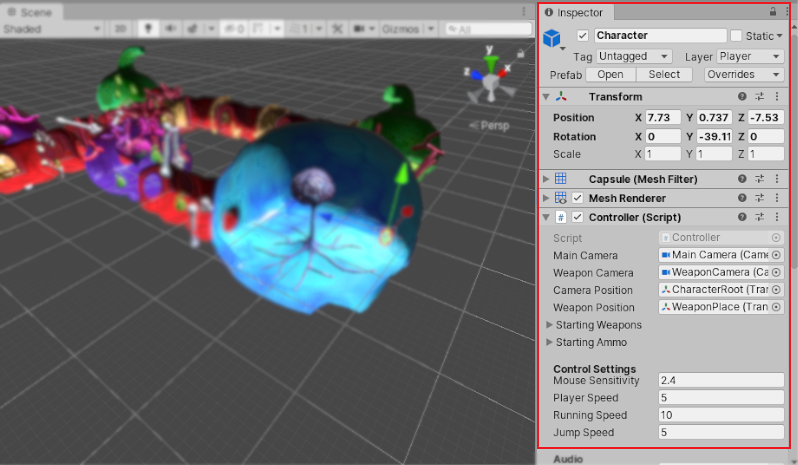
Opening an Inspector window
To open an Inspector window, do one of the following:
- From the menu, select Windows > General > Inspector to open a floating Inspector window.
- From any window’s More Items menu (⋮), select Add Tab > Inspector to open an Inspector in a new tab.
You can open as many Inspector windows as you want, and reposition, dock, and resize them in the same way you can any other window.
Controlling Inspector window focus
By default, an Inspector window displays properties for the current selection. The contents of the Inspector change whenever the selection changes. To keep the same set of properties open, regardless of the current selection, do one of the following:
- Lock the Inspector window to the current selection. When you lock an Inspector window, it no longer updates if you change the selection.
- Open a focused Inspector for a GameObject, Asset, or component. Focused Inspectors only ever display the properties of the items you opened them for.
Inspecting items
What you can see and edit in an Inspector window depends on what you select. This section describes what an Inspector window displays for different types of items you can select.
Inspecting GameObjects
When you select a GameObject (for example, in the Hierarchy or Scene view), the Inspector displays the properties of all of its components and Materials. You can edit the properties, and reorder the components in the Inspector window.
Inspecting custom script components
When GameObjects have custom script components attached, the Inspector displays the scripts’ public variables. You can edit script variables in the same way as you edit any other properties, which means that you can set parameters and default values in your scripts without modifying the code.
For more information, see Variables and the Inspector in the Scripting section.
Inspecting Assets
When you select an Asset (for example, from the Project window), the Inspector displays settings that control how Unity imports and uses the Asset at runtime.
Each type of Asset has its own settings. Examples of Asset import settings that you edit in an Inspector window include the:
- Model Import Settings window.
- Audio Clip Import Settings window.
- Texture Import Settings window.
Inspecting settings and preferences
When you open the Project Settings (menu: Editor > Project Settings), Unity displays them in an Inspector window.
Inspecting Prefabs
When you work with Prefabs, the Inspector window displays some additional information and provides some additional options. For example:
- When you Edit a Prefab Instance, the Inspector window provides options for working with the Prefab Asset and applying overrides.
- When you apply Instance overrides, the Inspector window displays the names of properties you override in bold.
For more information about working with Prefabs in the Inspector window, see the Prefabs section.
Inspecting multiple Items
When you have two or more items selected, you can edit all of the properties they have in common in an Inspector window. Unity copies the values you supply to all the selected items. The Inspector window displays a count of the number of selected items.
Multiple GameObjects
When you select multiple GameObjects, the Inspector window displays all of the components they have in common.
- For property values that are different across two or more selected GameObjects, the Inspector displays a dash (-) (1 in the screenshot below).
- For property values that are the same across all selected GameObjects, the Inspector displays the actual values (2 in the screenshot below).
- To apply a property value from one selected GameObject to all of the selected GameObjects, right-click the property name and select Set to Value of [Name of GameObject] from the context menu (3 in the screenshot below).
- If any of the selected GameObjects has components that are not present on the other selected objects, the Inspector displays a message that some components are hidden.
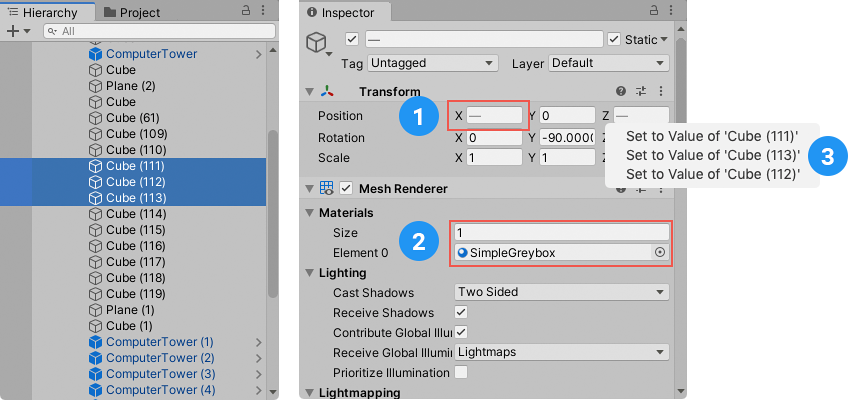
Multiple Assets
When you select multiple Assets of the same type, the Inspector window displays all of the properties they have in common.
- For property values that are the same across all selected Assets, the Inspector displays the actual values.
- For property values that are different across two or more selected Assets, the Inspector displays a dash (-) (1 in the screenshot below).
- For properties that you cannot edit for all of the selected Assets at once, the Inspector grays them out (2 in the screenshot below).
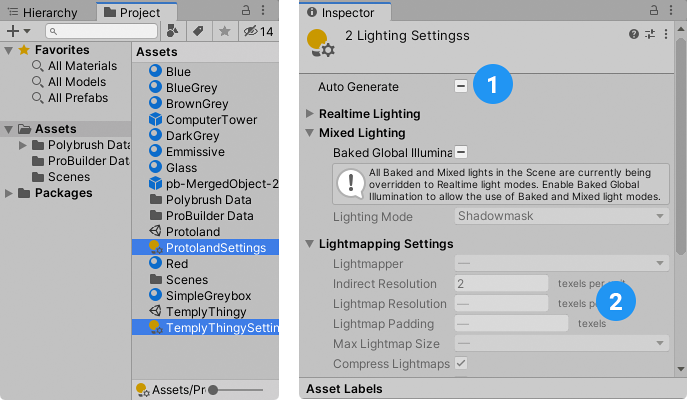
When you select multiple Assets of different types, the Inspector displays a list that shows how many of each type of Asset are selected. Click any item in the list to Inspect all Assets of that type.
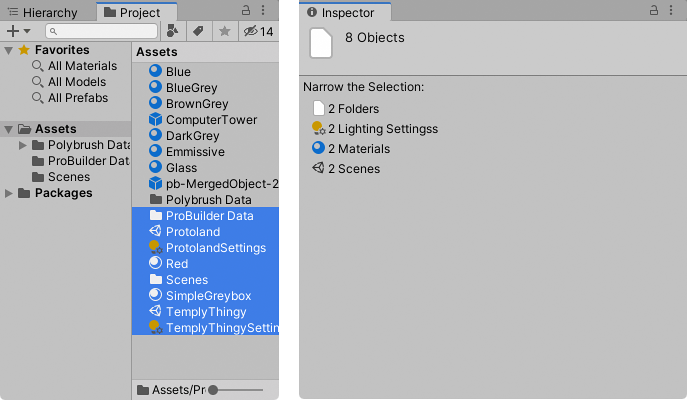
Multiple Prefabs
You can inspect multiple selected instances of a Prefab in the same way as you edit multiple GameObjects, but the Inspector hides the Select, Revert, and Apply buttons (see Editing a Prefab via its instances).
Locating an Inspector window’s source
When you open a GameObject or Asset in an Inspector window, you can locate it in the Scene view or Project View using the Ping command.
From the Inspector window’s More Items (⋮) menu, select Ping. Unity highlights the item in the Hierarchy view or the Project view.
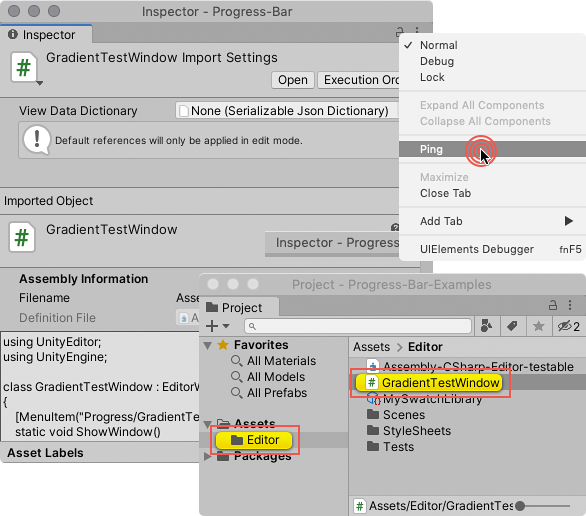
- 在 Unity 5.6 中添加了组件拖放功能
- 在 Unity 2020.1 中重新组织了 Inspector 部分页面